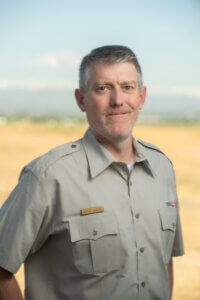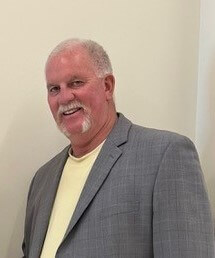CAMPS VERSUS HOTELS
A POTENTIAL COST-SAVING SCENARIO
BY JEFFREY MORISETTE, P.J. TILLMAN, DAVE LUCAS, KEITH PLAGEMANN, NATALIE COOPER, AND DAN DALLAS
Anyone who enjoys camping and travel knows that money can be saved by camping instead of staying in a hotel. These days, it is hard to find a hotel room for under $100 per night, meanwhile a campsite goes for well under $50. However, this calculus changes significantly for staff on an incident management team (IMT) evaluating lodging options during a wildland fire –a team that requires considerable daytime office space requirements.
In addition to sleeping and meals, many IMT functions are dependent on reliable internet and other basic office amenities. Building those capabilities into a remote camp is expensive and makes for a less reliable office (not to mention less comfortable).
There is quantitative evidence that using local hotels and office spaces can be more cost effective than the more traditional approach of setting up temporary living and office quarters in a fire camp for a Type 1 IMT on assignment.
For three recent incidents – Devil’s Knob in Oregon in September 2021, Tamarack in California in August 2021, and Lowline in Colorado in August 2023 – we compared costs for setting up temporary living and office quarters and the more novel approach of staying in nearby hotels, getting meals from restaurants or grocery stores using a standard per-diem allocation, and using a local facility for the meetings and day-to-day operations of the IMT.
The pandemic forced IMT staff to rethink traditional arrangements, changed the standards for fire incident logistics, and pushed teams to explore new approaches.
Leaders of the Rocky Mountain Incident Management Team 1 met this challenge by encouraging their logistics team to explore alternatives for setting up camp and the incident command post. In response, the team adopted a fixed facility approach when available. The fixed facility approach involves finding an existing local facility in proximity to both a town and the fire camp with enough room to set up a command post, a steady power supply, internet, and bathrooms. In the evenings, IMT operations staff stayed in local hotels and procured meals from local establishments with a standard daily allowance. Given the right circumstances, this innovation, which we evaluated in terms of cost-effectiveness, offers a new model for incident command posts with several additional benefits.
The cost comparison comes from the Rocky Mountain team, which calculated estimated expenses for the traditional camp set up and the fixed facility approach for each of the three fires. Traditional camp accommodations include everything from a landuse agreement to temporary housing, water-based infrastructure for personal hygiene and human waste, make-shift office structures, supplies and internet, an introduced energy source (i.e., generator), meal catering services, and lighting. Unlike the traditional camp approach, a fixed facility does not require assembling all the structures, services, and other accommodations. Instead, using hotel accommodations involves a shorter list of needs and preparations: hotel lodging; payment for use of office facilities; per-diem payments for meals at local restaurants; and the cost of a clerical trailer.
In evaluating this cost comparison, three considerations are worth noting. First, if the IMT staff are co- located with the traditional camp, the marginal cost increases; that is, per-person costs do not go down by having another 65 to 80 people residing full time at the fire camp. The cost to support a larger IMT staff at a camp requires additional land, showers, handwash facilities, porta-potties, light towers, water trucks, and other amenities. While some of these support items and associated costs are shared with other incident operations staff, typically these practical and logistical resources are required in addition to the supply allocated for operations. Sometimes IMT staff end up at a camp location separate from the operational camp.
Second, catered meals – hot breakfast, high-calorie sack lunch, and hot dinner – are specifically designed for firefighters; this costs approximately $80 a day per person. For the three locations, the meals and incidental expenses portion of a per-diem allowance – which is a fixed amount for U.S. federal employees and depends on location and relative cost of living – was always lower than a day’s worth of catered meals.
Finally, it is resource intensive to create a functioning office at a remote field camp. There are significant setup costs for yurts or trailers. There are additional costs for the required power, internet, and copiers. On the other hand, many costs of setting up a remote incident command post are almost entirely avoidable when the IMT works from an existing facility compared to constructing its own remote office space. For example, IMTs on the Tamarack and Lowline incidents used local schools, which were relatively inexpensive, provided sufficient space, and came with internet, copiers, desks, and meeting space. During the Devil’s Knob incident, a hotel casino’s conference rooms were used. Using the fixed facility approach, IMT staff cumulatively saved more than $100,000 on these three incidents.
While some incidents may be too remote to access fixed facilities and / or the community may not be as willing to accommodate an incident command post, the magnitude of potential savings makes it worthwhile to explore this option. These savings are especially important in the case of a fire with multi-agency responsibility, in which a local fire district can apply the savings to fire suppression and rehab activities.
In addition to the clear financial savings, the fixed facility approach offers a slew of potential secondary benefits to the local economy, relationships between the IMT and local community members, and conditions favorable to human health and safety. In the three case studies, the IMTs working with the local school systems built relationships with school district employees, which forged a stronger sense of community and solidarity during the wildfires. Furthermore, when IMT staff are on a per-diem meal and hotel allowance, they put revenue and tax dollars into local communities, resided in local hotels, and patronized local restaurants, grocery stores, and convenience stores for the duration of the assignment.
The fixed facility approach offers considerable benefits to human health and safety. According to the Medical Health and Public Advisory Team current wildland fire medical and public health guidance advises fire managers to do the following: “Reduce cumulative fatigue that may be present – especially later in the fire season. Rest and proper nutrition should be prioritized for each operational period” and “rigorous sanitary and personal hygiene practices are important for reducing the transmission of infectious diseases.” Hotel lodging is temperature controlled, smoke-free, and allows for adjustable levels of darkness. Hotel rooms make it easier to social distance, get a good night’s sleep, and maintain good personal hygiene compared to traditional incident command post camp locations. In turn, these conditions may help prevent losses to IMT capacity caused by infectious disease, which can otherwise stress an already taxed system of human resources.
In addition to the variety of benefits outlined above, there are some potential caveats when weighing the traditional camp versus the fixed facility approach. While hotel and daily allowance rates were favorable at the three fires, they may be higher at other locations. But, most likely, so, too, would be the expenses related to setting up the incident command post in a traditional camp. Also, the cost calculations presented here are contingent upon having a fixed facility available to use. Fall deployment might make it infeasible to use schools; however, churches, non-profit organizations, community centers, community organizations, and even for-profit locations with underutilized office space (such as hotel conference rooms) could all be considered. Another factor to keep in mind is the need to minimize the distance between fire camp and operations and the incident command post. In some cases, the fixed facility model may not be the better option if the footprint of the fire imposes long distances between the incident, firefighter camps, and the nearest local communities. For the three examples, that distance did not present any limitations on the IMTs to work from fixed facilities.
The main goal of any incident command team should be to put resources where they are needed. There are good reasons for all responders involved to be close to the incident, including IMT staff. But if local hotels and temporary office space allow for that proximity, permitting IMTs to utilize that option can not only cut costs but improve reliability of IMT functions, contribute to the local economies, build relationships with local communities, and increase on-site safety by reducing the risk of exposure to smoke and infectious disease.

While table 1 is not a comprehensive assessment or a statistically representative sample of incident management teams / incident command post locations and their respective costs and benefits, it does point to the utility – and arguably, the responsibility – of considering the fixed facility option. This cost comparison also suggests that a more comprehensive assessment might be worthwhile. Given this experience, we encourage agency administrators on fire incidents to explore venues within their communities that could support an incident command post, should the need arise. Establishing a list of potential options for office space within communities in proximity to their jurisdiction would be a proactive step that could lead to positive community engagement, potential cost savings, and healthier IMT deployment.






